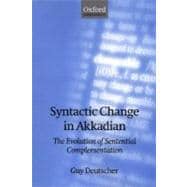
Note: Supplemental materials are not guaranteed with Rental or Used book purchases.
Purchase Benefits
What is included with this book?
| Preface | xi | ||||
| Abbreviations | xiii | ||||
| Sources, Text Editions | xv | ||||
| Part I Preliminary Chapters | |||||
|
3 | (4) | |||
|
7 | (10) | |||
|
7 | (5) | |||
|
12 | (1) | |||
|
13 | (1) | |||
|
14 | (3) | |||
|
17 | (20) | |||
|
18 | (2) | |||
|
20 | (1) | |||
|
21 | (2) | |||
|
23 | (7) | |||
|
30 | (7) | |||
| Part II Structural History: The Emergence of Complementizers and Quotatives | |||||
|
37 | (29) | |||
|
37 | (4) | |||
|
41 | (5) | |||
|
46 | (8) | |||
|
54 | (6) | |||
|
60 | (4) | |||
|
64 | (2) | |||
|
66 | (29) | |||
|
68 | (3) | |||
|
71 | (4) | |||
|
75 | (4) | |||
|
79 | (3) | |||
|
82 | (2) | |||
|
84 | (1) | |||
|
85 | (2) | |||
|
87 | (8) | |||
| Part III Functional History: The Changes in the Functional Domain of Complementation from 2500 BC to 500 BC | |||||
|
95 | (7) | |||
|
95 | (2) | |||
|
97 | (2) | |||
|
99 | (1) | |||
|
100 | (2) | |||
|
102 | (22) | |||
|
102 | (2) | |||
|
104 | (7) | |||
|
111 | (4) | |||
|
115 | (3) | |||
|
118 | (1) | |||
|
119 | (2) | |||
|
121 | (1) | |||
|
122 | (2) | |||
|
124 | (13) | |||
|
124 | (3) | |||
|
127 | (5) | |||
|
132 | (2) | |||
|
134 | (3) | |||
|
137 | (14) | |||
|
137 | (2) | |||
|
139 | (6) | |||
|
145 | (1) | |||
|
146 | (5) | |||
| Part IV The Development of Complementation as an Adaptive Process | |||||
|
151 | (13) | |||
|
151 | (2) | |||
|
153 | (1) | |||
|
153 | (5) | |||
|
158 | (2) | |||
|
160 | (4) | |||
|
164 | (23) | |||
|
164 | (1) | |||
|
165 | (2) | |||
|
167 | (8) | |||
|
175 | (6) | |||
|
181 | (3) | |||
|
184 | (3) | |||
| Glossary | 187 | (1) | |||
| References | 188 | (9) | |||
| Index of Subjects | 197 | (4) | |||
| Index of Quoted Texts | 201 |
The New copy of this book will include any supplemental materials advertised. Please check the title of the book to determine if it should include any access cards, study guides, lab manuals, CDs, etc.
The Used, Rental and eBook copies of this book are not guaranteed to include any supplemental materials. Typically, only the book itself is included. This is true even if the title states it includes any access cards, study guides, lab manuals, CDs, etc.